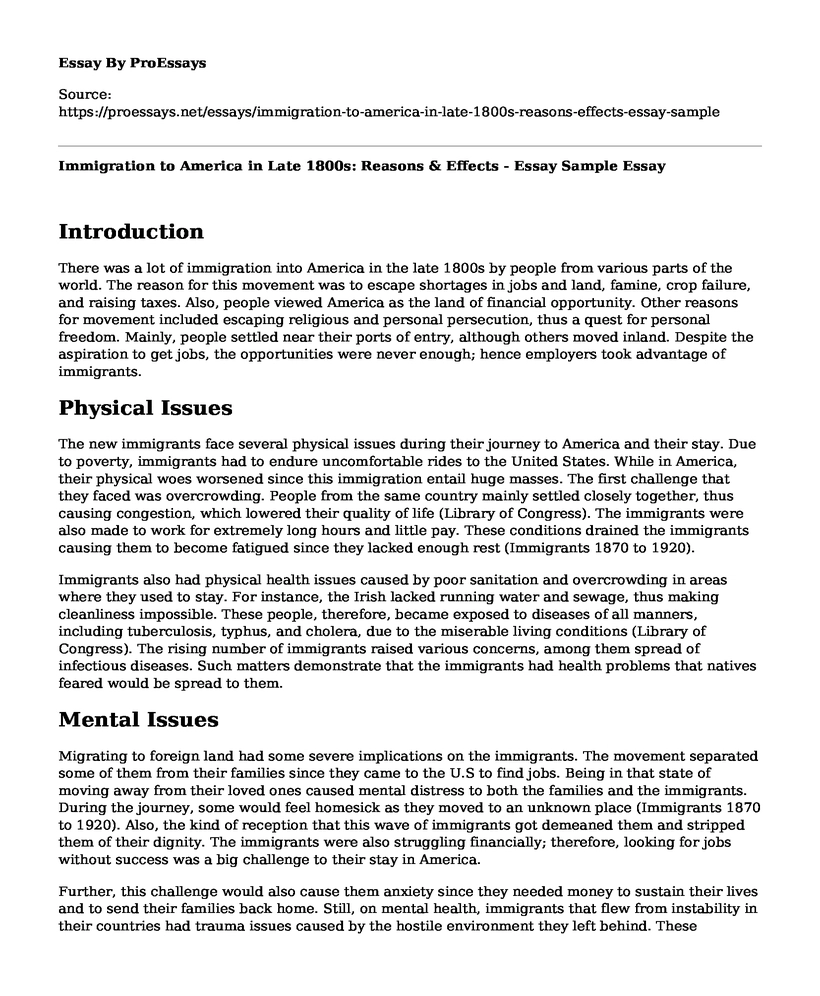Introduction
There was a lot of immigration into America in the late 1800s by people from various parts of the world. The reason for this movement was to escape shortages in jobs and land, famine, crop failure, and raising taxes. Also, people viewed America as the land of financial opportunity. Other reasons for movement included escaping religious and personal persecution, thus a quest for personal freedom. Mainly, people settled near their ports of entry, although others moved inland. Despite the aspiration to get jobs, the opportunities were never enough; hence employers took advantage of immigrants.
Physical Issues
The new immigrants face several physical issues during their journey to America and their stay. Due to poverty, immigrants had to endure uncomfortable rides to the United States. While in America, their physical woes worsened since this immigration entail huge masses. The first challenge that they faced was overcrowding. People from the same country mainly settled closely together, thus causing congestion, which lowered their quality of life (Library of Congress). The immigrants were also made to work for extremely long hours and little pay. These conditions drained the immigrants causing them to become fatigued since they lacked enough rest (Immigrants 1870 to 1920).
Immigrants also had physical health issues caused by poor sanitation and overcrowding in areas where they used to stay. For instance, the Irish lacked running water and sewage, thus making cleanliness impossible. These people, therefore, became exposed to diseases of all manners, including tuberculosis, typhus, and cholera, due to the miserable living conditions (Library of Congress). The rising number of immigrants raised various concerns, among them spread of infectious diseases. Such matters demonstrate that the immigrants had health problems that natives feared would be spread to them.
Mental Issues
Migrating to foreign land had some severe implications on the immigrants. The movement separated some of them from their families since they came to the U.S to find jobs. Being in that state of moving away from their loved ones caused mental distress to both the families and the immigrants. During the journey, some would feel homesick as they moved to an unknown place (Immigrants 1870 to 1920). Also, the kind of reception that this wave of immigrants got demeaned them and stripped them of their dignity. The immigrants were also struggling financially; therefore, looking for jobs without success was a big challenge to their stay in America.
Further, this challenge would also cause them anxiety since they needed money to sustain their lives and to send their families back home. Still, on mental health, immigrants that flew from instability in their countries had trauma issues caused by the hostile environment they left behind. These concerns affected the mental wellness of immigrants, although, for some, the situation improved with their stay in the U.S.
Social Issues
Discrimination
Immigrants were often discriminated against on the virtue of being foreigners. The discrimination manifested in areas like employment, owning property, and salaries. Immigrants struggled to find jobs since there were limited employment opportunities. The bias was perhaps because they were less skilled compared to natives. Also, due to a lack of jobs, whenever they were available, employers took advantage of immigrants and paid them poorly (Immigrants 1870 to 1920). However, this challenge was overcome through naturalization, whereby immigrants started to lose their accents and used American names.
Chinese immigrants also faced specific discrimination directed towards them. The Chinese came to America in large numbers seeking economic empowerment. Workers in the American economy resented the migration of Chinese, leading to legislation whose aim was to limit Chinese immigration in the United States (U.S. Department of State). Another reason for the resentment against the Chinese was that they worked for lower wages, thus pushing people who demanded higher pays of the job market. The Chinese were also accused of eroding America's moral fabric for engaging in activities such as gambling and smoking opium among their communities.
Assimilation
The movement of people into the U.S led to a mixture of cultures. This mixture later resulted in the absorption of cultures. Germans, for instance, immigrated massively and settled in the U.S. Later, 2.5 million immigrants that were German-born lived in the U.S. They mainly settled in Milwaukee, St. Louis, and Cincinnati an area that is popularly known as the German Triangle. In 1894, German-language journals being printed in the United States were about 800. However, by 1920, the number of publications had drastically dropped to about 200 prints ("Germans in America"). This drop was caused by the decline in immigration and increasing immigration.
Conclusion
In conclusion, immigration between 1870 and 1920 presented several challenges to the immigrants. Unfriendly work hours and poor living conditions made their stay in the U.S miserable. They also had mental issues caused by separation from their families and low wages. Socially, the immigrants had to grapple with discrimination from the natives that affected their settlement and changes of getting a job.
Works Cited
"Chinese Immigration and the Chinese Exclusion Act." U.S. Department of State, state.gov/r/pa/ho/time/gp/82014.htm. Accessed 10 March 2020.
"Immigrants 1870 - 1920". 2016, https://www.marionbrady.com/Americanhistory/Immigrants.pdf. Accessed 10 March 2020.
"Irish - Adaptation and Assimilation." Library of Congress, www.loc.gov/teachers/classroommaterials/presentationsandactivities/presentations/immigration/alt/irish3.html. Accessed 10 March 2020.
"The Germans in America: Chronology. Library of Congress, 23 Apr. 2014, www.loc.gov/rr/european/imde/germchro.html. Accessed 10 March 2020.
Cite this page
Immigration to America in Late 1800s: Reasons & Effects - Essay Sample. (2023, Apr 21). Retrieved from https://proessays.net/essays/immigration-to-america-in-late-1800s-reasons-effects-essay-sample
If you are the original author of this essay and no longer wish to have it published on the ProEssays website, please click below to request its removal:
- Meth Epidemic
- Alcoholics Anonymous and Twelve Step Programs Essay
- Immigration Split Personality Essay
- Essay on Aboriginal Women in US Suffer Double the Domestic Violence
- Essay Sample on Victim Services: Protecting the Vulnerable from Trafficking
- Ads: A Destructive Image of Women - Essay Sample
- Essay Example on Immigration: A Positive Force for the US Economy







